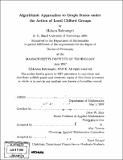Algorithmic approaches to graph states under the action of local Clifford groups
Author(s)
Bahramgiri, Moshen
DownloadFull printable version (3.419Mb)
Other Contributors
Massachusetts Institute of Technology. Dept. of Mathematics.
Advisor
Peter W. Shor.
Terms of use
Metadata
Show full item recordAbstract
Graph states are quantum states (quantum codes) in qn-dimensional space ... (q being a power of some prime number) which can be described by graphs with edges labeled from the field of order q, Fq. Graph states are determined as a common eigenvector of independent elements of the n-fold Pauli group, on which the local Clifford group has a natural action. This action induces the natural action of the local Clifford group on graph states and hence, its action on graphs. Locally equivalent graphs can be described using this action. For q being a prime number, two graphs are locally equivalent when they are located on the same orbit of this action, in other words, when there is an element of the local Clifford group mapping one graph to the other one. When q is some power of a prime number, the definition of this action is the natural generalization of this action in the case where q is prime. We translate the action of local Clifford groups on graphs to a set of linear and quadratic equations in the field F,. In the case that q is an odd number, given two arbitrary graphs, we present an efficient algorithm (polynomial in n) to verify whether these graphs are locally equivalent or not. Moreover, we present a computational method to calculate the number of inequivalent graph states. We give some estimations on the size of the orbits of this action on graphs, and prove that when either q is equal to 2 or is an odd number, the number of inequivalent quantum codes (i.e., the number of classes of equivalency) is equal to ..., which is essentially as large as the total number of graphs.
Description
Thesis (Ph. D.)--Massachusetts Institute of Technology, Dept. of Mathematics, 2007. Includes bibliographical references (p. 87-88).
Date issued
2007Department
Massachusetts Institute of Technology. Department of MathematicsPublisher
Massachusetts Institute of Technology
Keywords
Mathematics.